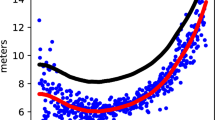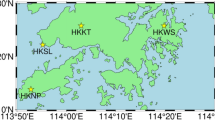Abstract
The global navigation satellite system (GNSS) can provide centimeter positioning accuracy at low costs. However, in order to obtain the desired high accuracy, it is necessary to use high-quality atmospheric models. We focus on the troposphere, which is an important topic of research in Brazil where the tropospheric characteristics are unique, both spatially and temporally. There are dry regions, which lie mainly in the central part of the country. However, the most interesting area for the investigation of tropospheric models is the wet region which is located in the Amazon forest. This region substantially affects the variability of humidity over other regions of Brazil. It provides a large quantity of water vapor through the humidity convergence zone, especially for the southeast region. The interconnection and large fluxes of water vapor can generate serious deficiencies in tropospheric modeling. The CPTEC/INPE (Center for Weather Forecasting and Climate Studies/Brazilian Institute for Space Research) has been providing since July 2012 a numerical weather prediction (NWP) model for South America, known as Eta. It has yield excellent results in weather prediction but has not been used in GNSS positioning. This NWP model was evaluated in precise point positioning (PPP) and network-based positioning. Concerning PPP, the best positioning results were obtained for the station SAGA, located in Amazon region. Using the NWP model, the 3D RMS are less than 10 cm for all 24 h of data, whereas the values reach approximately 60 cm for the Hopfield model. For network-based positioning, the best results were obtained mainly when the tropospheric characteristics are critical, in which case an improvement of up to 7.2 % was obtained in 3D RMS using NWP models.






Similar content being viewed by others

References
Alves DBM, Monico JFG (2011) GPS/VRS positioning using atmospheric modeling. GPS Solut 15(3):253–261
Alves DBM, Monico JFG, Dalbelo LFA, Sapucci LF, Camargo PO (2006) VRS concept using NWP and Mod_Ion_FK: preliminary results in Brazil. Proc. International FIG Congress. Munich, Germany, 1–14
Bevis M, Businger S, Chriswell S, Herring TA, Anthes RA, Rocken C et al (1994) GPS meteorology: mapping zenith wet delays onto precipitable water. J Appl Meteorol 33:379–386
Boehm J, Schuh H (2004) Vienna mapping functions in VLBI analyses. Geophys Res Lett. doi:10.1029/2003GL018984
Boehm J, Niell A, Tregoning P, Schuh H (2006a) Global mapping function (GMF): a new empirical mapping function based on numerical weather model data. Geophys Res Lett 33(7):1–4. doi:10.1029/2005GL025546
Boehm J, Werl B, Schuh H (2006b) Troposphere mapping functions for GPS and very long baseline interferometry from European centre for medium-range weather forecasts operational analysis data. J Geophys Res 111(B2):1–9. doi:10.1029/2005JB003629
Boehm J, Heinkelmann R, Schuh H (2007) Short note: a global model of pressure and temperature for geodetic applications. J Geod 81(10):679–683. doi:10.1007/s00190-007-0135-3
Chou SC, Bustamante JF, Gomes JL (2005) Evaluation of seasonal precipitation forecasts over South America using Eta model. Nonlin Proc Geophys 12:537–555
Davis JL, Herring TA, Shapiro I, Rogers AE, Elgened G (1985) Geodesy by interferometry: effects of atmospheric modeling errors on estimates of base line length. Radio Sci 20:1593–1607
Hobiger T, Ichikawa R, Koyama Y, Kondo T (2008) Fast and accurate ray-tracing algorithms for real-time space geodetic applications using numerical weather models. J Geophys Res 113(D20302):1–14. doi:10.1029/2008JD010503
Hobigera T, Shimadab S, Shimizub S, Ichikawaa R, Koyamaa Y, Kondoa T (2010) Improving GPS positioning estimates during extreme weather situations by the help of fine-mesh numerical weather models. J Atmos Solar Terr Phys 72:262–270
Hopfield HS (1969) Two-quartic tropospheric refractivity profile for correcting satellite data. J Geophys Res 74(18):4487–4499
Janjic ZI (1984) Nonlinear advection schemes and energy cascade on semi-staggered grids. Mon Weather Rev 112(6):1234–1245
Janjic ZI (1990) The step-mountain coordinate: physical package. Mon Weather Rev 118(7):1429–1443
Jensen ABO, Tscherning CC, Madsen F (2002) Integrating numerical weather predictions in GPS positioning. Proc. of the European navigation conference GNSS 2002, Copenhagen, Published by Nordic Navigation Forum, 1–8
Jupp SM, Powe J, Owen J, Butcher (2003) Use of numerical weather prediction fields for the improvement of tropospheric corrections in global positioning applications. Proc. ION GPS 2003, Institute of Navigation, Portland, Oregon, 9–12 September, 377–389
Marques H A, Monico JFG, Shimabukuro M H, Oyama RT, Aquino M (2012) Satellite clock corrections for real time PPP: a case study in the context of the Brazilian continuous GPS network. Proc. ION GNSS 2012, Nashville, EUA, 17–21
Mesinger F (1984) A blocking technique for representation of mountains in atmospheric models. Riv Meteorol Aeronaut 44:195–202
Mesinger F, Janjic ZI (1974) Noise due to time-dependent boundary conditions in limited area models. The GARP programme on numerical experimentation. Rep. WMO, Geneva 4:31–32
Mesinger F, Lobocki L (1991) Sensitivity to the parameterization of surface fluxes in NMC’s Eta model. In 9th conference on numerical weather prediction, Denver. Am Meteorol Soc, pp 213–216
Mesinger F, Janjic ZI, Nickovic S, Gavrilov D, Deaven DG (1988) The step-mountain coordinate: model description, and performance for cases of Alpine lee cyclogenesis and for a case of an Appalachian redevelopment. Mon Weather Rev 116(7):1493–1518
Mesinger F et al (2012) An upgraded version of the Eta model. Meteorol Atmos Phys. doi:10.1007/s00703-012-0182-z
Niell AE (2001) Preliminary evaluation of atmospheric mapping functions based on numerical weather models. Phys Chem Earth 26:475–480
Niell AE (1996) Global mapping functions for the atmosphere delay at radio wavelengths. J Geophys Res 101(B2):3227–3246
Richardson LF (1922) Weather prediction by numerical process. Cambridge University Press, London
Rocken C, Sokolovskiy S, Johnson JM, Hunt D (2001) improved mapping of tropospheric delay. J Atmos Oceanic Technol 18:1205–1213
Sapucci LF, Machado LAT, Monico JFG, Plana-Fattori A (2007) Intercomparison of integrated water vapor estimative from multi-sensor in amazonian regions. J Atmos Oceanic Technol 24:1880–1894
Schüler T, Chüler T, Hein G W, Eissfeller B (2003) Improved tropospheric delay modeling using an integrated approach of numerical weather models and GPS. Proc. ION GPS 2003, Portland, Oregon, 600–615
Smith EK, Weintraub S (1953) The constants in the equation for atmospheric refractive index at radio frequencies. J Res Natl Bur Stand 50(1):39–41 (Research Paper 2385)
Spilker JJ Jr (1996) Tropospheric effects on GPS. Am Inst Aeronaut Astronaut 1:517–546
Teunissen PJG (1998) Quality control and GPS. In: Teunissen PJG, Kleusberg (1998) A GPS for geodesy, Berlin: Springer 2: 271–318
Acknowledgments
The authors would like to thank FAPESP and CNPq for the financial support provided to this research (FAPESP research project—process number 2012/19906-7; CNPQ research scholarship—process number 303079/2011-8).
Author information
Authors and Affiliations
Corresponding author
Rights and permissions
About this article
Cite this article
Alves, D.B.M., Sapucci, L.F., Marques, H.A. et al. Using a regional numerical weather prediction model for GNSS positioning over Brazil. GPS Solut 20, 677–685 (2016). https://doi.org/10.1007/s10291-015-0477-x
Received:
Accepted:
Published:
Issue Date:
DOI: https://doi.org/10.1007/s10291-015-0477-x



